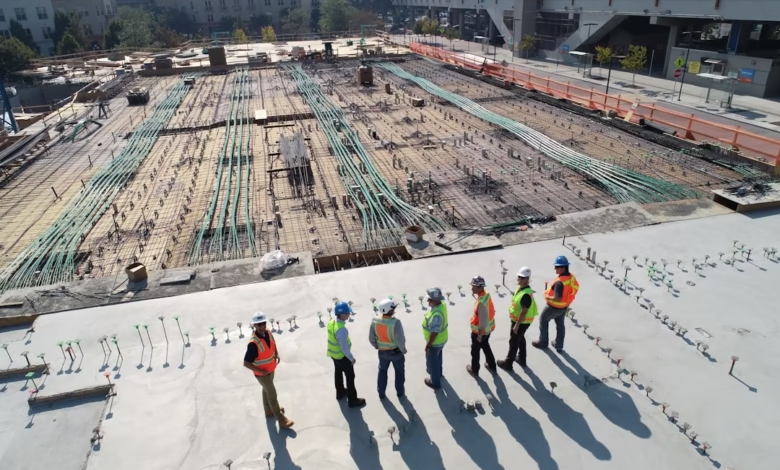The Future of Construction Metals: Exploring Steel, Aluminum, and Sustainable Innovations in Metal Fabrication

In the ever-evolving landscape of construction, the choice of materials plays a pivotal role in determining the durability, sustainability, and overall performance of a building. Among the various building materials available, metals stand out due to their versatility and strength. This article delves into the critical role of ferrous and non-ferrous metals, such as steel and aluminum, in modern construction. We will explore the innovative advancements in sustainable metal production and recycling, highlighting how metal fabrication techniques are evolving to meet industry demands. Furthermore, we will examine emerging trends related to base metals, precious metals, and rare earth metals, and their significant impact on building materials. As we navigate through this metal-centric journey, we will uncover the influences of metal mining, metallurgy, and the latest trends in metal commodities—including the rise of battery metals and the integration of 3D printing technologies in construction. Join us as we uncover the multifaceted world of construction metals and their vital role in shaping the future of the built environment.
- 1. The Role of Ferrous and Non-Ferrous Metals in Modern Construction: Steel, Aluminum, and Beyond
- 2. Sustainable Metal Production and Recycling: Innovations in Metal Fabrication for the Construction Industry
- 3. Exploring Metal Trends: From Base Metals to Rare Earth Metals and Their Impact on Building Materials
1. The Role of Ferrous and Non-Ferrous Metals in Modern Construction: Steel, Aluminum, and Beyond
In modern construction, the role of metals is indispensable, with both ferrous and non-ferrous metals playing critical roles in the development of buildings, infrastructure, and various materials. Ferrous metals, primarily consisting of iron and its alloys, are foundational in construction due to their strength, durability, and ability to withstand heavy loads. Steel, a prominent ferrous metal, is widely used in structural frameworks, offering resilience and flexibility that are essential for skyscrapers, bridges, and industrial facilities. The metallurgy of steel allows for various metal alloys to be created, enhancing its properties for specific applications.
Conversely, non-ferrous metals, such as aluminum, copper, zinc, and lithium, provide unique advantages that complement ferrous metals in modern construction. Aluminum, known for its lightweight nature and resistance to corrosion, is increasingly used in architectural designs, window frames, and roofing systems. Its metal fabrication capabilities allow for intricate designs while maintaining structural integrity. Copper, another important non-ferrous metal, is commonly utilized in electrical wiring and plumbing due to its excellent conductivity and resistance to corrosion.
Beyond these primary metals, the construction industry is also evolving to incorporate rare earth metals and precious metals, which are becoming increasingly important in specialized applications. For example, platinum and palladium are used in catalytic converters, making them vital for automotive industries striving for sustainable practices. Moreover, the rise of energy metals, such as lithium, is transforming construction techniques, particularly in the production of battery storage solutions for renewable energy systems.
Metal trends in construction are also shifting towards sustainability, with a growing emphasis on metal recycling and sustainable metal production. As industries seek to reduce their carbon footprints, the recycling of base metals and industrial metals has become a key focus. Metal mining practices are also evolving to minimize environmental impacts, and the integration of 3D printing metals is paving the way for innovative construction methods that reduce waste and enhance efficiency.
In conclusion, both ferrous and non-ferrous metals are vital to modern construction, providing strength, versatility, and sustainability. As the industry continues to evolve, the adoption of new metal trends and technologies, including metal alloys and advanced fabrication techniques, will shape the future of construction materials, ensuring they meet the demands of a changing world.
2. Sustainable Metal Production and Recycling: Innovations in Metal Fabrication for the Construction Industry
Sustainable metal production and recycling are increasingly becoming essential components of the construction industry, addressing environmental concerns while ensuring that the demand for construction metals is met. As industries strive for sustainability, innovations in metal fabrication are leading the charge in transforming how metals are produced, used, and recycled.
One of the key aspects of sustainable metal production is the focus on reducing waste and energy use during the metal mining process. By adopting more efficient practices, such as using advanced metallurgy techniques, companies can minimize the environmental impact associated with extracting base metals like steel, aluminum, copper, and zinc. New technologies in metal extraction and processing not only lower energy consumption but also enhance the quality of industrial metals.
Metal recycling plays a pivotal role in sustainable practices. The recycling of ferrous and non-ferrous metals significantly reduces the need for virgin material extraction, leading to lower carbon emissions and conservation of natural resources. For instance, recycling steel and aluminum can save up to 95% of the energy required to produce new metal from raw ore. Innovative techniques in metal fabrication, such as 3D printing metals, allow for the use of recycled materials, further contributing to a circular economy.
Additionally, the focus on precious metals, rare earth metals, and battery metals has grown due to their increasing demand in various sectors, including construction, aerospace, and automotive industries. The advancement in metal alloys has facilitated the development of stronger, lighter materials that are essential for modern construction while also promoting sustainability.
Investing in sustainable practices not only benefits the environment but also opens opportunities in gold investing, silver investing, and other metal commodities. As the market for energy metals and refractory metals expands, the construction industry can leverage these trends to enhance the durability and performance of buildings, while also addressing metal corrosion concerns.
In summary, the integration of sustainable metal production and recycling innovations in metal fabrication is crucial for the construction industry. By embracing these advancements, companies can ensure they meet the growing demand for construction metals while minimizing their ecological footprint and paving the way for a more sustainable future.
3. Exploring Metal Trends: From Base Metals to Rare Earth Metals and Their Impact on Building Materials
The construction industry is witnessing a significant evolution in the use of metals, driven by innovative technologies and changing market demands. Exploring metal trends reveals a diverse landscape, from base metals like steel and aluminum to more specialized materials such as rare earth metals and precious metals. Each category of metal plays a crucial role in building materials, influencing everything from structural integrity to aesthetic appeal.
Base metals, including copper, zinc, and aluminum, are essential for construction due to their excellent properties such as corrosion resistance and malleability. Steel, an industrial metal, remains a cornerstone in construction due to its strength and versatility. Metal alloys, which combine various metals to enhance performance, are increasingly used to meet the specific needs of modern architecture and engineering.
On the other end of the spectrum are rare earth metals, which have gained prominence due to their application in high-tech industries, including aerospace and energy. These metals are critical for manufacturing advanced components that require exceptional durability and heat resistance, showcasing the importance of metallurgy in modern construction materials.
Additionally, the trend towards sustainable metal production is reshaping how construction materials are sourced and utilized. Metal recycling has become a vital practice, reducing waste and minimizing the environmental impact of metal mining. This shift towards a circular economy not only helps in conserving natural resources but also supports the growing market for eco-friendly construction practices.
Furthermore, as technology advances, the emergence of 3D printing metals is revolutionizing the manufacturing process in construction. This method allows for the creation of complex structures with reduced waste and increased efficiency, offering a glimpse into the future of metal fabrication.
Investors are also taking note of these trends, with gold investing and silver investing becoming attractive options as the demand for these precious metals rises. The volatility of metal commodities often prompts strategic investments in industrial metals, which are essential for infrastructure development.
In conclusion, the landscape of construction metals is rapidly changing, shaped by advancements in technology, sustainability efforts, and market trends. Understanding these dynamics provides insight into the future of building materials and their impact on the construction industry as a whole. As we continue to explore these metal trends, it will be crucial for industry stakeholders to adapt and innovate to meet the evolving demands of modern construction.
In conclusion, the construction industry is increasingly reliant on a diverse array of metals, from industrial staples like steel and aluminum to the more specialized applications of rare earth metals and metal alloys. As we have explored throughout this article, both ferrous and non-ferrous metals play crucial roles in modern building practices, significantly influencing everything from structural integrity to aesthetic appeal.
Moreover, the focus on sustainable metal production and recycling is reshaping the landscape of metal fabrication in construction. Innovations in metallurgy and advancements in recycling processes are paving the way for a more sustainable future, minimizing waste and reducing the environmental impact of metal mining.
As trends evolve, we see a growing interest in precious metals, battery metals, and aerospace metals, reflecting the diverse applications of metals beyond construction. With metal commodities becoming increasingly valuable in investments—such as gold and silver investing—stakeholders must stay informed about market dynamics and the implications of metal trends.
Ultimately, as the construction sector embraces innovative solutions like 3D printing metals and continues to adapt to the challenges of metal corrosion and sustainability, it is clear that the future of construction metals is bright and full of potential. By understanding the significance of these materials and their properties, we can ensure that construction practices not only meet today’s needs but also pave the way for a resilient and sustainable future.
References:
[Include your list of sources here]




